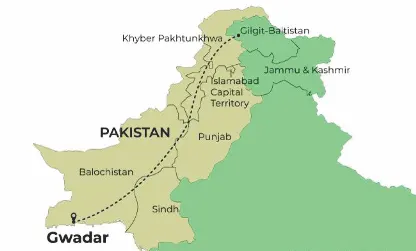Federal Minister for Planning & Development Ahsan Iqbal has been diligently working to persuade Chinese authorities to expedite the completion of pending projects within the China-Pakistan Economic Corridor (CPEC) during his most recent visit. However, a mutually agreed “scheme of arrangement” is seemingly hard to achieve because of numerous socio-economic, geopolitical and geostrategic impediments.
The pending payments of the Chinese companies have reached Rs.580 billion, increasing terrorist incidents, compromised safety and security of the Chinese nationals and the CPEC projects, ongoing political instability, prolonged economic uncertainty and unending power struggle among the main stakeholders have further dimmed the prospects of attracting more and more inflow of the FDIs.
At the geostrategic level, the US’s China containment policies are gaining momentum, especially in South China Sea, whereas, India has established its own “Necklace of Diamond Strategy” in the Indian Ocean to further enhance its naval cooperation, engagements, development aid and investment.
Prime Minister Narendra Modi’s larger “Act East” Plan, also intends to strengthen ties with ASEAN and address concerns about China’s maritime dominance. India has established facilities in Duqm Port, Oman; the Mozambique Channel; the Strait of Malacca; Sunda Strait; Lombok Strait; and the Changi naval base. It also gained military access to Indonesia’s Sabang Port in 2018.
Most recently, India signed a 10 year contract with Iran to develop and operate the Iranian port of Chabahar which will have serious spillover socio-economic, geopolitical and geostrategic repercussions for the regional stakeholders in terms of security and safety in the days to come. India has also placed a significant emphasis on the Quadrilateral Security Dialogue (QUAD) alliance it shares with the US, Japan, and Australia, as these countries utilize this forum to cooperate in strategic intelligence and military exercises to contain China.
On the other hand, China has pursued its peaceful “Strings of Pearls maritime strategy” to protect its Indian Ocean strategic interests. Initially, it sought to expand the “Maritime Silk Road” via the Thai Canal, and subsequently circumvent “Singapore’s Strait of Malacca”. Afterwards, it involved major investment in the construction of ports in coastal South Asian and African countries like Bangladesh, Myanmar, Pakistan, Sri Lanka, the Maldives, and Tanzania.
Despite being hailed as a “great place-name” for the future by American author Robert D. Kaplan during his 2009 visit, Gwadar has yet to realize its full economic potential and status as a connecting trading hub. While significant development and investment, notably from China through CPEC, have occurred, local communities have not benefited as expected. Urgent new approaches are needed to ensure Gwadar’s strategic importance is realized and benefits are shared more equitably. Additionally, Gwadar’s strategic value is undeniable, providing Pakistan with a less vulnerable port option compared to Karachi and Bin Qasim in times of regional tensions.
However, the “Great Land Robbery” published in June 2008 highlighted how the poor people of Gwadar were being denied rights over their ancestral lands by investors and developers from Sindh and Punjab and triggered sentiments of socio-economic isolation and marginalization. Thus the Baloch nationalist groups, who already had a history of armed struggle, intensified their attacks on the port, allied facilities and Chinese nationals working on these projects.
In summary, Gwadar still remains Pakistan’s great asset, a jewel. It is suggested that the stake of the people of Balochistan in the development of Gwadar and other CPEC projects should be prioritized as soon as possible. Local residents should be engaged and promised grant of their share in the benefits coming out of the projects.
Unfortunately, Balochistan is lagging far behind other provinces in terms of new jobs, health facilities, education, shelter, social development, and last but not least clean drinking water.
It is suggested that China, being an important stakeholder in the CPEC project, should contribute more in the socio-economic development of local people of Balochistan especially Gwadar. China should apply and follow an new “Model of Social and Human Reverse Engineering” to de-radicalized the youth and rectified terrorist mentality of the Baloch people by helping the federal, provincial and local government of Gwadar in the development of public service facilities, such as schools, hospitals and skill development centres, as well as measures aimed at the provision of clean drinking water, among others, to the local population, creating their stake in the projects.
The universities and educational institutions in Balochistan should be clubbed with Chinese universities, to offer dual degree programs in the social and sciences disciplines under CPEC projects. The employment of the residents of Balochistan in the projects would enhance their stake as well as save the Chinese currently working in their place from security risks, till the situation improves.
Gwadar port symbolizes stability, peace and prosperity for Pakistan. It is a natural deep-sea port which can host bigger ships than Karachi. It sits at the crossroads of the global oil trade. And it would consolidate China’s regional interests.
Gwadar, despite being completed in 2007, has only logged 22 ships in its best year to date. It has also failed to attract any regularly scheduled deep-sea shipping lines.
It means Gwadar processes almost no cargo that could generate income for Pakistan. Gwadar is operating at very limited capacity. The port’s three berths where loading and unloading takes place, can handle 137,000 standard 20-foot shipping containers per year. In contrast, Karachi and its 33 berths can handle the equivalent of 4.2 million 20-foot containers per year.
Unfortunately, much of the supporting infrastructure, including roads and railways needed to transport cargo to and from Gwadar, is also missing.
Fencing of Gwadar city may be a good solution but only for a shorter period. The policy makers and main stakeholders should come out of their deep slumbers to act swiftly and accordingly to tackle the emerging anti Pak-China socio-economic alliances, geopolitical partnerships and geostrategic accords. Gwadar is a jewel of the CPEC which must be protected by China and Pakistan.









